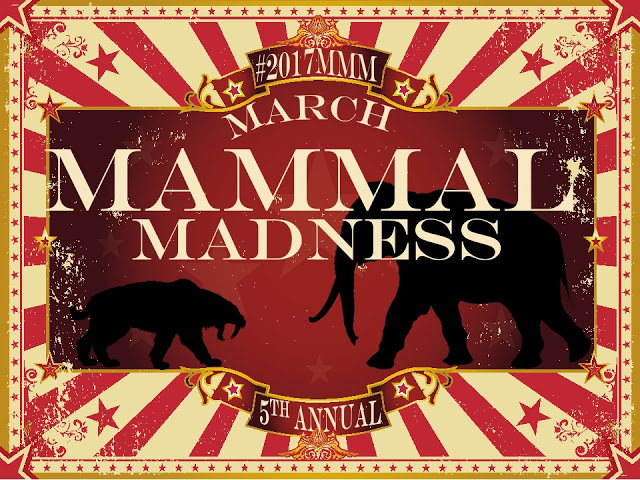For this blog entry I wanted to discuss an interesting ‘Science-Twitter’ phenomenon called March Mammal Madness. While this is the fifth annual event, this is the first year I’ve participated and I couldn’t be happier to share this event with other wildlife enthusiasts!
March Mammal Madness (MMM) is curated by some clever folks at Arizona State University and is an ode to the American NCAA College Basketball March Madness Championship Tournament, where 64 college basketball teams compete for the championship.
MMM borrows many of the same characteristics as the original basketball tournament, but it is simulated. Each species is assigned scores based on a range of biological attributes, such as behaviour, weaponry, armor, body size, speed, and physiology, all of which are determined from the scientific literature. Combats between species are then simulated and a computer algorithm determines the outcome based on the attributes of the species involved and the habitat in which the battle takes place. It’s as simple as that! For additional information and details, you can check out the blog here. As is the case for the basketball tournament, all you need to do is fill in a bracket. While some people invest significant research time into each pick, it’s just as easy to pick your favorite mammals and hope for the best! While hard-core sports fans select winners in their March Madness brackets and tune in to watch their favorite basketball teams play sports-ball (as we call it in my house), the Science-Twitter-verse is having some fun with MMM!
The first matchup was a play-in game between ‘wild-card’ mammals, and happened on March 6 amid building excitement! It was a heated battle between the fisher, snow leopard, rhesus macaque, and red giant flying squirrel. I picked the fisher to win, because they are widespread across boreal North America and have a reputation for being vicious creatures. Alas, I guessed wrong. The red giant flying squirrel out-competed the field in a heated battle, as the snow leopard came close, but succumbed to the overwhelming heat and humidity of the tropical rain forest where the battle took place.
After the play-in game was decided, the brackets were officially set: four brackets, each with eight mammal-on-mammal matchups. While the mammals could be randomly chosen and assigned to brackets, the curators of MMM place mammals into categories ranging from biologically relevant, to silly and imaginative. This year, the bracket themes are:
- ‘Adjective Mammals’, where the name of each mammal is prefaced with an adjective, for example, clouded leopard, silky anteater.
- ‘Desert Adapted Mammals’, which included only mammals that live in desert environments, for example, the Tibetan sand fox, bilby.
- ‘Coulda Shoulda Mammals’, a bracket where half the mammals are extinct or mythical and the other half still around, for example, lion, Greek Sphinx.
- ‘Two Animals, One Mammal’, a bracket where each mammal has a two-part name, with both parts being names of different animals, for example, hog deer, squirrel monkey.
You can see a full list of all the first round matchups here. As of March 10, 2017, the first two brackets had been decided with a range of outcomes. Matchups are simulated and the events are live-tweeted with scientifically accurate details about both species involved. For instance, information about general ecology, diet, morphology, and conservation are often included. In the case of the Jerboa (Desert bracket), we learned they are currently listed as ‘Least Concern’ by the International Union for Conservation of Nature (IUCN), but are under threat of habitat loss from anthropogenic and agricultural invasion into their natural habitat. We also learned Jerboa’s are desert specialists in Europe with very large hind legs for jumping, an adaptation that requires very long leg and foot bones. Matchup recaps and information about each mammal are available for round one of the Adjective Mammals and Desert Adapted brackets (which happened March 8 & 9, respectively).
Okay, to summarize: yes, MMM is silly! But, I think there are some important things happening here. First, what a fun and creative way for everyone from grade school students to professors to engage in discussions about mammal diversity! Detailed, accurate information about the species involved in the tournament is provided by the MMM curators as well as the Journal of Mammalogy, a peer-reviewed academic journal. These sources encourage learning and discussion throughout the event. Over 200 grade school educators requested an early release of the bracket so it could be incorporated into lesson planning. Amazing! In fact, there is even an anecdote on the MMM website describing how an eighth grader posed as a teacher to get early access to the bracket because they were so excited! Wow – that’s commitment!
Second, for those of us working with and/or studying mammals, or even other animals, MMM is a great opportunity to reconnect with what inspired our current work – our passion and interest in animals and the amazing world around us. As a result, it was fairly easy to convince my lab-mates and supervisor to participate – now there are eight of us participating, all with different strategies and theories for which mammal could or should win each matchup. For example, a colleague living in another province said in an email: “Being new to this March madness business, I never thought I would be cheering for a screaming hairy armadillo…but I was!” Meanwhile, those of us in the office at Memorial were comparing brackets intently and trying to determine whether a tiger could defeat a sea lion in the water. As one of us said, “Clearly the tiger would win on land, but I’m not sure it would be very effective in the water!” For anyone, like me, who probably said this exact same sentence as a child, MMM is a fun and engaging way to let your animal-nerdiness shine! Take all your eye-roll inducing mammal facts and apply them where they will be recognized and appreciated – March Mammal Madness has descended upon us!
